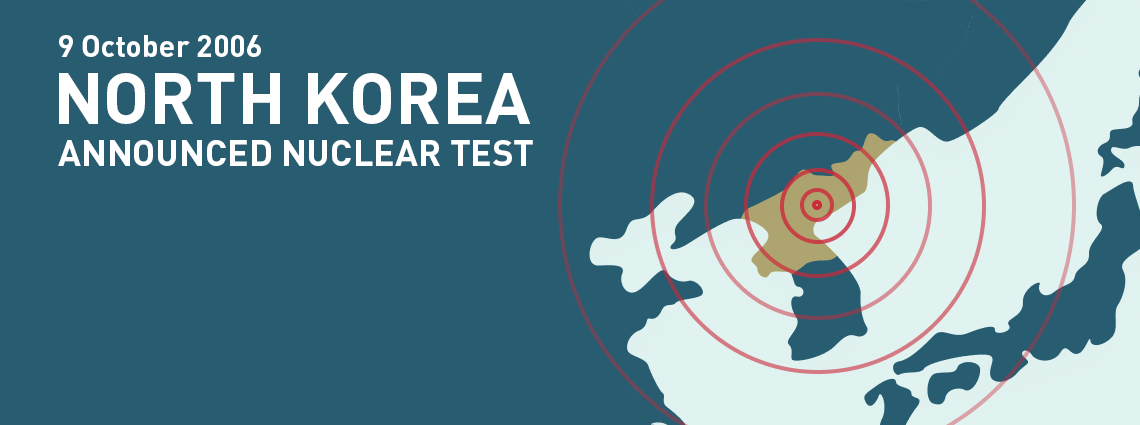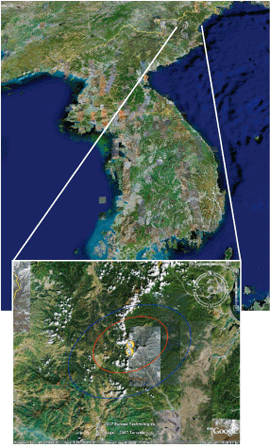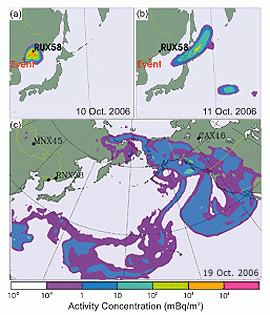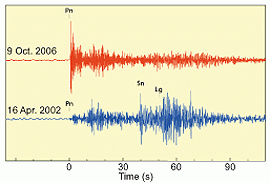2006 DPRK Announced Nuclear Test
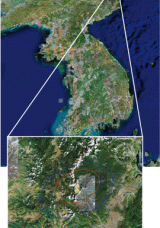
Data analysis resulted in the identification of a potential inspection area of less than 1000 square kilometres as illustrated by the red ellipse.
The announcement by the Democratic People's Republic of Korea or DPRK on 9 October 2006 that it had conducted a nuclear test was met with practically unanimous global expressions of concern. The UN Security Council strongly condemned the act as a clear threat to international peace and security. The Chairman and the Executive Secretary of the Preparatory Commission for the Comprehensive Nuclear-Test-Ban Treaty Organization (CTBTO), as well as States Signatories expressed grave concern at the declared test and characterized the event as an action against the letter and the spirit of the Comprehensive Nuclear-Test-Ban Treaty (CTBT).
For the CTBTO and the global alarm system it is building, the event represented a real-life test case. Designed to verify compliance with the CTBT, the verification regime will monitor the earth for nuclear explosions once the Treaty enters into force. Although completed only partially and operating in test mode, the CTBT verification regime proved that it was capable of meeting the expectations set for it. The announced test was well recorded throughout the world by the CTBTO's International Monitoring System (IMS). Over twenty seismic stations of the IMS located throughout the world, including one as far away as South America, detected signals originating from the event.
Less than two hours later, States Signatories received the first automatic analysis of the data, containing preliminary information on time, location and magnitude of the event. As there was considerable interest in this event among States Signatories, analysts at the International Data Centre in Vienna expedited analysis of the seismic data, applying timelines as envisaged under the Treaty. As a result, a detailed analysis of the event on 9 October 2006 was issued and distributed to States Signatories on 11 October 2006.
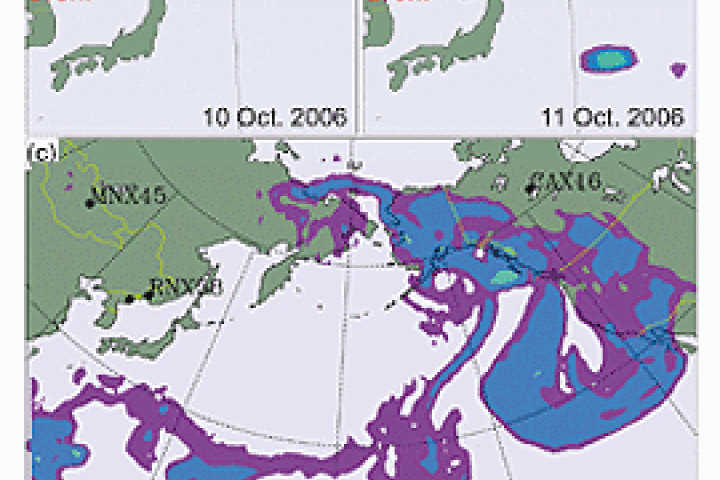
Hypothesized dispersion of radioactive noble gas Xenon 133 shown one (a), two (b) and (c) 10 days after the declared nuclear test.
The findings based on the so-called waveform technologies - seismic, hydroacoustic and infrasound - are used to identify the area for a possible on-site inspection. This final verification measure can be invoked by the future Executive Council once the Treaty enters into force. Under the Treaty, an on-site inspection area is to be no more than 1000 square kilometres.
In the case of the event of 9 October 2006, analysis of all available data allowed for the identification of a potential inspection area of considerably less than 1000 square kilometres. The radionuclide technology, measuring radionuclide particles or noble gases in the air, is applied to provide ultimate proof of a nuclear explosion. Radioactive noble gases are of particular interest. Due to their ability to seep through layers of rock into the air, they would be the only evidence of a well-contained underground nuclear explosion. Dispersed by the winds, traces of noble gases would eventually be registered at a radionuclide station equipped with the relevant technology.
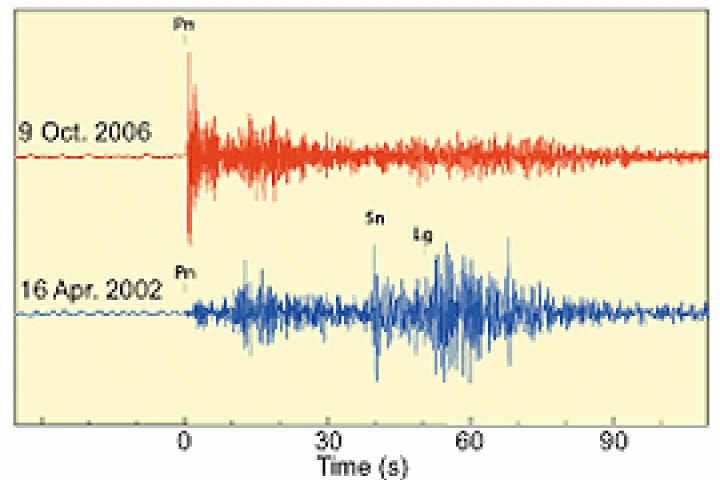
Seismograms for the declared nuclear test and from an earlier earthquake, recorded at primary seismic station PS31 at Wonju, Republic of Korea.
Two weeks after the event, the radionuclide noble gas station at Yellowknife, Canada, registered a higher concentration of Xenon 133. Applying atmospheric transport models to backtrack the dispersion of the gas, its registration at Yellowknife was found to be consistent with a hypothesized release from the event in the DPRK. At the time of the announced nuclear explosion by the DPRK, only ten out of the planned forty stations with noble gas measuring technology were operational in test-mode. The contribution of this technology to the analysis of the event on 9 October demonstrated its significant role in the CTBT verification system.
The event in the DPRK was a test for the CTBT verification system, for its reliability and technical capabilities. The system has proven its value for the purpose for which it was designed - receiving and reviewing data on a specific event and providing highly qualitative information to States Signatories, enabling them to make their own judgments. The event underlined the need for early entry into force of the Treaty and the rapid completion of the CTBT verification regime's build-up. Those States that have not yet joined the CTBTO family are encouraged to make that step in order to have the Treaty enter into force.
28 Mar 2008
Related information
UN News Centre. 3 October 2006
Annan expresses concern after DPR Korea says it will conduct nuclear test
CTBTO Press Release PI/2006/13
Statement by Tibor Tóth, Executive Secretary of the CTBTO PrepCom, 6 October 2006
CTBTO Press Release PI/2006/14
Statement by Ambassador Volodymyr Yelchenko, Chairman of the Preparatory Commission for the Comprehensive Nuclear-Test-Ban Treaty Organization, 6 October 2006
CTBTO Press Release PI/2006/15
Statement by Ambassador Volodymyr Yelchenko, Chairperson of the Preparatory Commission for the Comprehensive Nuclear-Test-Ban Treaty Organization, 9 October 2006
CTBTO Press Release PI/2006/16
Statement by Tibor Tóth, Executive Secretary of the Comprehensive Nuclear-Test-Ban Treaty Organization, 9 October 2006
CTBTO Press Release PI/2006/17
The Preparatory Commission for the Comprehensive Nuclear-Test-Ban Treaty Organization held a Special Session in connection with the announcement of the Democratic People's Republic of Korea to have conducted an underground nuclear test, 13 October 2006
Special Feature 2: The Event of 9 October 2006: A Test Case for the CTBT Verification Regime
CTBTO newsletter Spectrum, issue # 9, page 5Statement by UN Secretary-General Ban Ki-moon
CTBTO newsletter Spectrum, issue # 9, pages 24 and 28North Korea: a real test for the CTBT verification system?
by Dr. Robert G. Pearce
North Korea: a real test for the CTBT verification system? Part II: noble gas observations
by MSc Paul R.J. Saey, Dr Andreas Becker and Dr Gerhard Wotowa
Forensic seismology and CTBT verification
by Professor Paul G. Richards
